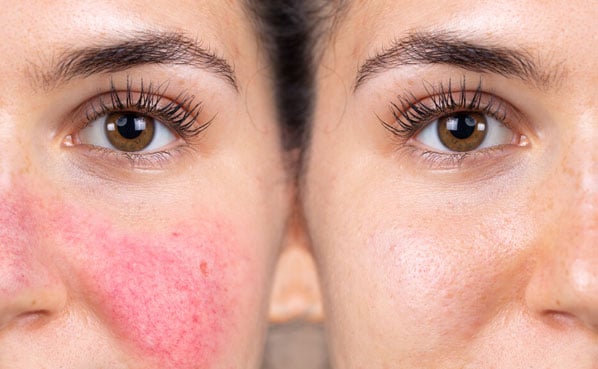Facial Redness Treatment: Everything you need to know about rosacea

Rosacea is a very common skin condition that exclusively affects the face. Rosacea is not contagious. It is often characterised by the tendency to flush and blush more easily than others. If rosacea is left untreated, it can become worse over time. Symptoms of rosacea include enlarged capillaries, a permanent flushed appearance across the nose and cheeks, non-tender lumps under the skin, mild swelling to the cheeks and nose, yellow-headed pimples across the nose, cheeks and chin, or a burning or stinging sensation.
Rosacea affects both men and women, but is almost three times more common in women. It has a peak onset age of between 30 and 60. The condition can be controlled, managed and improved with proper treatment methods; however there is no specific or long term cure.
Genetics, particularly being of Northern European heritage can increase the likelihood of suffering from rosacea. Triggers also play a very important role in understanding what causes flare-ups. Often alcohol, spicy foods, stress, caffeine, being overly cold or dry climates can irritate the skin and cause a flare-up. Some recent research also suggests that rosacea sufferers might have s sensitivity to a microscopic mite that is found in the skin.
Diagnosis of rosacea is made by taking a full medical history and thorough examination of the affected area. Rosacea must be distinguished from other, similar types of skin conditions, such as acne, seborrhoeic dermatitis, perioral dermatitis and systemic lupus erythematosus.
Some complications of rosacea can be conjunctivitis (inflammation of the membrane of the eye) or rhinophyma (the skin on the nose becomes severely reddened and swollen and is caused by enlargement of the sebaceous gland; this complication is more common in men).
Rosacea can be managed by avoiding known triggers – such as spicy food, alcohol etc., Antibiotic therapy (can reduce the severity of the flare-up), topical medical-grade creams and gels (can reduce the severity of the flare-up and reduce the symptoms of discomfort), laser treatment (to shut down the enlarged capillaries) and blue light LED treatment.
Rosacea affects both men and women, but is almost three times more common in women. It has a peak onset age of between 30 and 60. The condition typically begins as redness on the central part of the face, across the cheeks, nose, or forehead, but can also less commonly affect the neck, chest, ears, and scalp. It can be controlled, managed and improved with proper treatment methods; however there is no specific or long term cure.
The first step in determining what treatment will work is to understand this skin condition and outbreak triggers. The doctors at Main Street Cosmetic and Skin will thoroughly educate you on the condition and influences surrounding your individual case and instruct you on management strategies, such as avoiding stress and heavy physical exercise, keep the skin well moisturised and avoid anything that dehydrates the skin or that raises core body temperature.
Rosacea affects both men and women, but is almost three times more common in women. It has a peak onset age of between 30 and 60. The condition can be controlled, managed and improved with proper treatment methods; however there is no specific or long term cure.
Genetics, particularly being of Northern European heritage can increase the likelihood of suffering from rosacea. Triggers also play a very important role in understanding what causes flare-ups. Often alcohol, spicy foods, stress, caffeine, being overly cold or dry climates can irritate the skin and cause a flare-up. Some recent research also suggests that rosacea sufferers might have s sensitivity to a microscopic mite that is found in the skin.
Diagnosis of rosacea is made by taking a full medical history and thorough examination of the affected area. Rosacea must be distinguished from other, similar types of skin conditions, such as acne, seborrhoeic dermatitis, perioral dermatitis and systemic lupus erythematosus.
Some complications of rosacea can be conjunctivitis (inflammation of the membrane of the eye) or rhinophyma (the skin on the nose becomes severely reddened and swollen and is caused by enlargement of the sebaceous gland; this complication is more common in men).
Rosacea can be managed by avoiding known triggers – such as spicy food, alcohol etc., Antibiotic therapy (can reduce the severity of the flare-up), topical medical-grade creams and gels (can reduce the severity of the flare-up and reduce the symptoms of discomfort), laser treatment (to shut down the enlarged capillaries) and blue light LED treatment.
Rosacea affects both men and women, but is almost three times more common in women. It has a peak onset age of between 30 and 60. The condition typically begins as redness on the central part of the face, across the cheeks, nose, or forehead, but can also less commonly affect the neck, chest, ears, and scalp. It can be controlled, managed and improved with proper treatment methods; however there is no specific or long term cure.
The first step in determining what treatment will work is to understand this skin condition and outbreak triggers. The doctors at Main Street Cosmetic and Skin will thoroughly educate you on the condition and influences surrounding your individual case and instruct you on management strategies, such as avoiding stress and heavy physical exercise, keep the skin well moisturised and avoid anything that dehydrates the skin or that raises core body temperature.